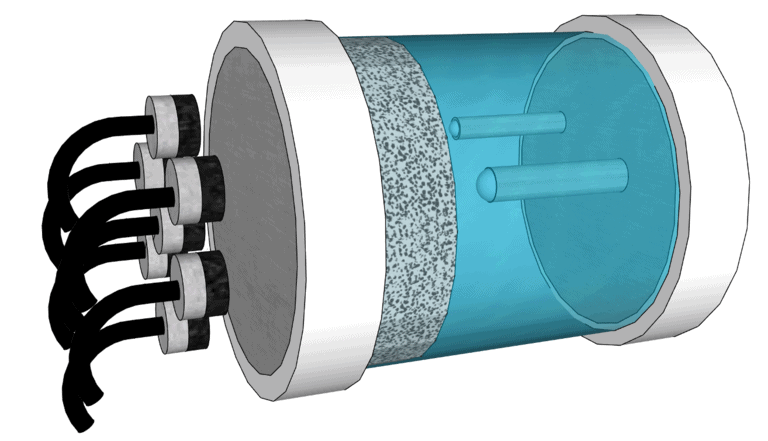Metals embedded in concrete can erode, rusting, and weakening until the concrete splits and the structure it supports falls. Such corrosion is believed to be one of the main issues that exacerbated the damage that led to the June 24 Surfside, Florida, condominium collapse, according to the U.S. Department of Commerce’s National Institute of Standards and Technology (NIST).
This corrosion is one of the biggest global durability challenges across infrastructure in all fields, according to Juan Pablo “JP” Gevaudan, assistant professor of architectural engineering and principal investigator of a three-year, $800,000 grant from the U.S. Department of Energy’s (DOE) Nuclear Energy University Program that will further explore the electrochemical corrosion degradation science of concrete as it applies to high-level nuclear waste (HLNW).
Defined by the DOE as any radioactive material that requires permanent isolation, HLNW can result from processing nuclear fuel and produce radionuclides, radioactive atoms that are inherently unstable and harmful to life. Currently, HLNW is packaged in metal canisters and embedded in concrete. Gevaudan’s collaborators include Andrea Argüelles, assistant professor of engineering science and mechanics, and Rebecca Napolitano, assistant professor of architectural engineering.
“Understanding and preventing corrosion — especially in infrastructure — is one of our great global durability challenges,” Gevaudan said. “The degradation science of concrete applies to many engineering fields, and we all want to improve our infrastructure.”
According to Gevaudan, when he and his collaborators learned of the challenges at the end-of-life of nuclear fuel cycles, they immediately saw synergy between architectural engineering’s goal of improving the durability of the built environment with the DOE’s goal of studying corrosion in embedded HLNW metal canisters to extend the service life of the nuclear waste disposal infrastructure. To expand this synergy across University Park, Gevaudan said, the team has already met with faculty in the Ken and Mary Alice Lindquist Department of Nuclear Engineering to identify areas where their work may align, and they plan to continue their discussions on areas of convergent research.
“In this unique project, our goal is to create a new material that can protect the HLNW metal canisters, which contain the waste byproducts of reactions that occur in nuclear reactors,” Gevaudan said. “We hope we will develop a new cement-based buffer material that can immobilize harmful radionuclides that, in a critical situation, might leak from the HLNW canisters and keep the waste from reaching the environment and humans — which would be a catastrophe.”
For this project, Gevaudan will leverage recent advances by his research group, the Responsive and Adaptive Infrastructure Materials (Re-AIM) research group, utilizing organic and inorganic chemistry interactions to develop precisely designed, modern concrete materials. To predict degradation over time of these new buffer materials, Napolitano will create digital twins of systems to model proposed solutions and test potential outcomes. Argüelles will employ ultrasonic testing of the metal interface in a bespoke arrangement to non-destructively assess the corrosion potential of different buffer material formulations. Together, the team plans to spend the first 18 months of the grant period, which starts in October, developing a concrete that can bind harmful waste leaking from a reactor’s metal canister. During the second 18 months, they plan to improve the buffer material to help prevent the metal canister from corroding in the first place.
“It is said that reinforcement steel and concrete are best friends,” Gevaudan said. “The microstructural properties of concrete allow the steel to develop a passive layer, a kind of protective shell that protects it from corrosion — but it can break down due to age or environmental aggressors. The material we are developing will create a passive layer that will prevent corrosion over thousands to, potentially, millions of years.”
To help achieve a long-lasting, effective material, Gevaudan said, the team is purchasing an automated reactor from Mettler Toledo, a company that produces precision instruments for a range of fields. With the reactor, the researchers can synthesize modern cement materials with desired properties in precisely controlled conditions with high repeatability. The machine also helps track the phases formed in the new cements, which allows the researchers to learn more about specific mineral configurations that evolve as the cementitious material is created.
“We’ll be able to quickly identify which phase best binds radionuclides of interest, which will help us fast-track the development of the material,” Gevaudan said. “This grant allowed us to bring this advanced technology to cement research, which has traditionally used methodologies stuck in the past.”
The grant will also help fund student researchers to work on the project as they complete their degrees in architectural engineering, chemical engineering, engineering science and mechanics and acoustics, as well as other related disciplines. Gevaudan said the team plans to grow and has a specific interest in students who are traditionally underrepresented in engineering and are pursuing graduate degrees.
“Besides the science, one of the most-rewarding aspects about this project is building our team,” Gevaudan said. “This project symbolizes a group effort led by three early-career faculty members who are all underrepresented in engineering. We worked hard to earn this grant, and I’m proud of the work we have done and will continue to do to work across disciplines to prevent steel corrosion — one of the most pervasive degradation challenges we have.”


